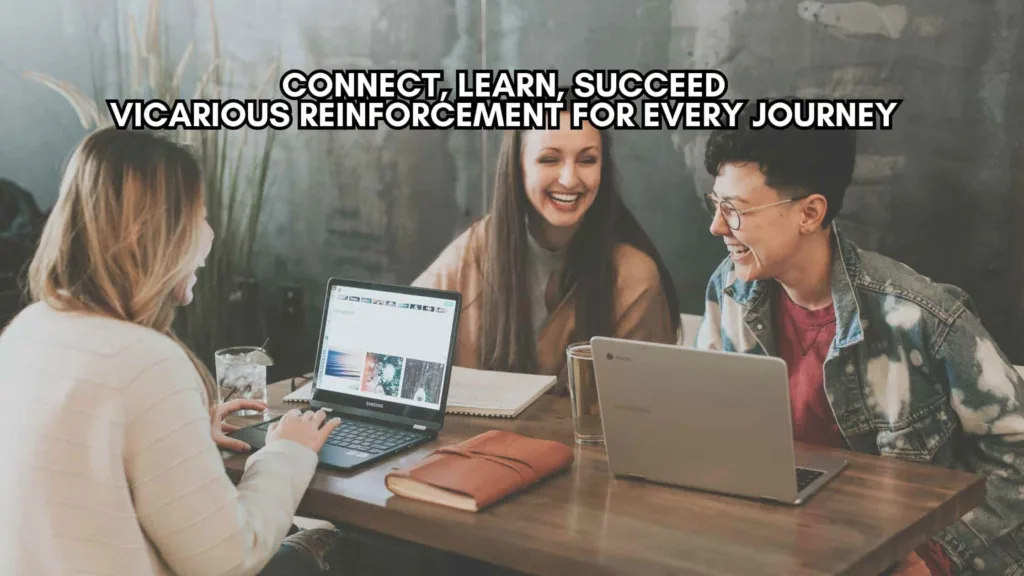Vicarious Reinforcement is an important idea from social learning theory, and it really affects how people act. Albert Bandura, a famous psychologist, came up with this concept. Basically, it’s when people watch what happens to others when they do something and then change their own behavior based on that. Unlike when you directly experience the results of your actions, vicarious reinforcement happens when you learn from watching others. In this article, we’ll take a closer look at how vicarious reinforcement works, how it’s used, and what it means for individuals and society.
Mechanisms of Vicarious Reinforcement
- Watching and Learning: Vicarious reinforcement starts with people observing others. It’s like watching a friend, a family member, or someone else doing something, and paying attention to what happens next.
Example: Imagine you see your friend always saying “please” and “thank you.” You notice people like them more, so you start saying those words too.
- Remembering What You See: After watching, it’s important to remember what you observed. This involves storing that information in your mind so you can recall it later.
Example: You watch a YouTube video about fixing a bike. To actually fix your own bike later, you need to remember the steps you saw in the video.
- Copying the Behavior: The next step is copying or imitating what you saw. If you noticed someone being rewarded or praised for their actions, you might be more likely to try the same thing.
Example: Your sister always finishes her homework early and gets praised by your parents. Seeing this, you decide to start doing your homework early too.
- Motivation Matters: Whether or not you imitate the behavior depends on motivation. If you saw positive outcomes, like getting a reward, you might feel motivated to do the same. On the other hand, if there were negative consequences, you might decide to avoid that behavior.
Positive Motivation Example: Your classmate always shares snacks, and everyone likes them. You want people to like you too, so you start sharing snacks.
Negative Motivation Example: Your friend got in trouble for not doing homework. You don’t want that to happen to you, so you make sure to always do your homework.
In simpler terms, vicarious reinforcement is like learning from others by watching what they do, remembering it, trying it out yourself, and deciding whether to keep doing it based on what you saw happen to them.

Applications of Vicarious Reinforcement
Let’s see how vicarious reinforcement is used in everyday life:
- Learning at School: It’s like when you see your classmates doing well and getting praised by the teacher. It makes you think, “Hey, if I study like them, maybe I’ll get praised too!”
- Being Nice to Others: When you see someone being friendly and helpful, you might think, “That looks good! I want to be nice like them.” It’s like learning good behavior by watching others.
- Watching TV and Movies: Think about your favorite characters in shows or movies. If they get rewarded for doing something good, you might think, “I should do good things too, just like them.”
- Having Role Models: Imagine a famous person you really admire, like a sports star. If they’re praised for working hard, you might think, “I want to work hard like them and be successful too.”
In simple words, vicarious reinforcement happens all around us, helping us learn from others and decide how we want to behave based on what we see.
Related Topic: Vicarious Conditioning: Shared Experiences and Understanding
Implications and Criticisms
Now, let’s look at what happens and what people think about vicarious reinforcement:
- Thinking about Right and Wrong: When we see someone being rewarded for doing something good, it makes us think, “That’s the right thing to do.” But sometimes, people worry that if others get rewarded for something not so good, it might send the wrong message.
- Being Fair and Kind: Vicarious reinforcement can encourage us to be fair and kind because we see others being praised for those behaviors. But, some people argue that it’s important to think for ourselves and not just copy what we see.
- Learning from Mistakes: If we observe someone facing consequences for their actions, it can teach us what not to do. However, some criticize this, saying it might not always be fair to judge people solely based on their mistakes.
- Making Good Choices: Vicarious reinforcement helps us make choices by looking at what happens to others. But, some people say it’s crucial to consider our own values and not just follow what everyone else is doing.
In simpler terms, vicarious reinforcement has both good and not-so-good sides. It helps us learn right from wrong, but we also need to be careful and think for ourselves.
On Top of That:
To sum it up, vicarious reinforcement is a big deal in how people act, learn, and get influenced. It affects education, how we fit into society, and what we see on TV or online. Knowing how it works and how we use it can help us do good things and make positive changes. But we also need to be careful about what we learn from others, considering what’s right and wrong. As we keep learning about how people influence each other, vicarious reinforcement turns out to be a strong force in shaping how we behave, both as individuals and as a group.

Pingback: Chivalry is Dead? Critical Modern Relationships
Pingback: 3 Ways to Promote and Support Early Childhood Development - Healthy Child